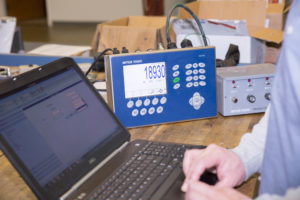How Often Should Scales Be Calibrated?

The Quick and Easy Answer…..
…it all depends on your process tolerances and ISO procedures. Some applications may need scale calibration at the beginning of every shift in order to maintain compliance, while other applications may only need a scale checked once every 90 days.
What About Process Tolerance?
So the real question is how is process tolerance determined? The best place to start is to look at material cost as it relates to inaccuracy. How much money do you lose when a scale is inaccurate by 5 lbs versus 50 lbs? How much product are you going to be giving away? Is that figure possible to live with? If that figure is not, lower the amount of weight tolerance until you find an amount of inaccuracy that is possible to live with. Some applications may need incredibly precise weighing while others are acceptable being off 20 to 50 lbs. Once process tolerance figures are identified, regular calibration intervals can be determined.
How Often Should I Calibrate My Equipment?
Why should maintenance happen at regular intervals? Why not call whenever the scales are noticeably out? The question, once again, is answered within the frame of process tolerance. Can profit margins take the hit of accidentally giving away tons of product a year? By the time a scale is noticeably out of tolerance, you have already lost a lot of money. Having scales checked in regular intervals lowers the likelihood of weighing errors and allows for a third party to examine that section of your production for any possible efficiency opportunities.
So Calibration Fixes Everything, Right?
It is also important to note, that scale calibration alone will not fix any underlying issues with a scale. Recalibration often only masks the real problem with weight readings. Scale errors can occur in a variety of circumstances from complex load cell issues to simply weight readouts not being plugged in. Many companies choose to allow scale users to calibrate scales, rather than going with a scale provider. Different personnel using a variety of calibration methods will result in error-prone calibrations, shortcuts taken, and weight placement at different locations on the scale during calibration. This also causes inaccuracies in weight readings. Scale providers are trained to ensure that the equipment is being run optimally and that no underlying issues are causing scale errors.
A much safer approach is to use the concept of weight validation with users internally. Weight validation allows for more root cause analysis when dealing with scale issues internally. When adding a known weight to a scale, scale users ensure that the device is weighing properly and know when it is not. No parameters are changed with the device by operators. It also helps to train users to spot basic errors, like a scale being pushed against a wall, that can cause weighing issues.
Carlton Scale’s service department has decades of calibration, preventative maintenance, and service experience. Our customer count on us to make sure their scales are always up and running. Request your free asset evaluation today and join the thousands of our customers who know what it’s like to be Weigh Better®
